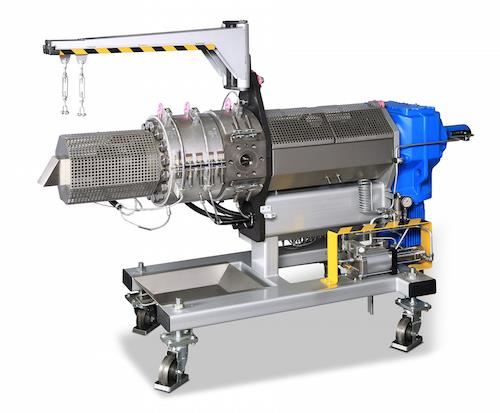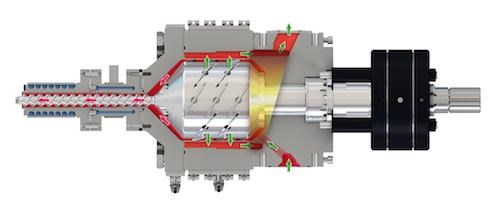RECYCLING: New Melt Filtration System for Highly Contaminated Plastics
The new system from Nordson seeks to boost recycling productivity and minimize melt loss.
Nordson Corp., Westlake, Ohio, will introduce a new melt filtration system for recycling highly contaminated plastics at K 2016 (Hall 9, Stand A44/48).
The BKG HiCon R-Type 250 Nordson Polymer Processing Systems (PPS) equipment transforms highly contaminated polyolefin or styrenic plastics into clean, high-quality material and exhibits less melt loss than with traditional backflush systems for highly contaminated plastics, says Nordson PPS business unit director, Sven Conrad.
The central concept of the HiCon R-Type 250 system involves the use of a cylindrical “separating head” with knives arranged on its surface in a helical pattern designed to move contaminant particles forward as the head rotates. Enclosing the head is a stationary filter element called a “strainer tube.” When contaminated melt from an entry port flows into the cylindrical space between the rotating head and the strainer tube, the knives capture the contaminant while the contaminant-free melt moves through the strainer into flow channels that lead to an exit port. At the same time, the rotating head turns a screw which guides the contaminated material through cooling sections and finally to where it is discharged into collecting bins.
“Nordson’s newest development cleans much more efficiently than commercial available filtration systems for highly contaminated polymers,” says Conrad. “The special design makes possible a uniform load on the strainer tube during the cleaning process, providing an extended lifetime for the filter and scrapers and increasing the overall efficiency of the system at far less melt loss.”
A powerful drive actuates the separation head / discharge-screw assembly. The HiCon R-Type 250 system operates at a maximum pressure of 350 bar and maximum temperature of 320 °C. Throughput can range from 500 to 1,500 kg/h. The rate depends on polymer viscosity, filtration fineness, levels of contamination, and other factors. As it exits the system, filtered polymer is maintained at a constant pressure, ensuring uniform processing downstream.
One key to the efficiency with which the HiCon R-type 250 system removes contaminants is the design of the steel strainer tubes, which are available with micro-holes ranging from 120 to 750 microns. The holes are conical in shape, permitting passage of molten polymer while preventing blockage by contaminant. This design and the symmetrically positioned knives in the drum contribute to the long working life of the tube before it needs to be replaced. Once cleaned, moreover, the tube can be reused.
Replacing a strainer tube is facilitated by a built-in swiveling arm for removing the strainer tube housing, and by a hand-operated hydraulic device for disassembling it. To ensure uninterrupted production, it is possible to operate two HiCon R-type 250 systems in parallel.
“A network of several Siemens SIMATIC control and monitoring units contributes to the high level of automation and ease of use that distinguish the HiCon R-type 250 system,” says Rolf Schultheis, Nordson PPS manager of electrical engineering. “The Siemens control system is intuitive, instantly providing a visualization of all process parameters. The onboard Ethernet / Profibus interface opens the possibility of integrating communication with other devices, collecting and recording production data, and even performing remote maintenance.”
HiCo R-type melt filtration systems are available from Nordson worldwide.
Related Content
Foam-Core Multilayer Blow Molding: How It’s Done
Learn here how to take advantage of new lightweighting and recycle utilization opportunities in consumer packaging, thanks to a collaboration of leaders in microcellular foaming and multilayer head design.
Read MorePregis Performance Flexibles: In the ‘Wow’ Business
Pregis went big and bold with investment in a brand-new, state-of-the-art plant and spent big on expanding an existing facility. High-tech lines, well-known leadership and a commitment to sustainability are bringing the “wow” factor to blown film.
Read MoreAvoid Four Common Traps In Granulation
Today, more than ever, granulation is an important step in the total production process. Our expert explains a few of the many common traps to avoid when thinking about granulators
Read MoreScaling Up Sustainable Solutions for Fiber Reinforced Composite Materials
Oak Ridge National Laboratory's Sustainable Manufacturing Technologies Group helps industrial partners tackle the sustainability challenges presented by fiber-reinforced composite materials.
Read MoreRead Next
How Polymer Melts in Single-Screw Extruders
Understanding how polymer melts in a single-screw extruder could help you optimize your screw design to eliminate defect-causing solid polymer fragments.
Read MorePeople 4.0 – How to Get Buy-In from Your Staff for Industry 4.0 Systems
Implementing a production monitoring system as the foundation of a ‘smart factory’ is about integrating people with new technology as much as it is about integrating machines and computers. Here are tips from a company that has gone through the process.
Read MoreAdvanced Recycling: Beyond Pyrolysis
Consumer-product brand owners increasingly see advanced chemical recycling as a necessary complement to mechanical recycling if they are to meet ambitious goals for a circular economy in the next decade. Dozens of technology providers are developing new technologies to overcome the limitations of existing pyrolysis methods and to commercialize various alternative approaches to chemical recycling of plastics.
Read More















